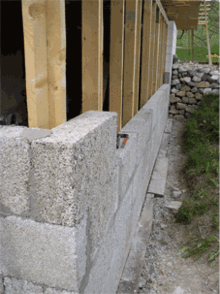Hempcrete
[3] Typically, hempcrete has good thermal and acoustic insulation capabilities, but low mechanical performance, specifically compressive strength.
[10] Canada has followed France's direction in the organic building technologies sector, and hempcrete has become a growing innovation in Ontario and Quebec.
[7] The second technique consists of stacking prefabricated blocks that are delivered to the project site similar to masonry construction.
[7] Once hempcrete technology is implemented between timber framing, drywall or plaster is added for aesthetics and increased durability.
[7] Hempcrete can be used for many purposes in buildings, including roof, wall, slab, and render insulation, each of which has its formulation and dosages of the various constituents respectively.
The coefficient of variance (COV) indicates the dispersion of experimental results and is important in understanding the variability among hempcrete properties.
[4] Hempcrete's low density material and resistance to cracking under movement make it suitable for use in earthquake-prone areas.
[clarification needed] Hempcrete walls are fireproof, transmit humidity, resist mould, and have excellent acoustic performance.
Hemp concrete has a low thermal conductivity, ranging from 0.06 to 0.6 W m−1 K−1,[24][15][25] a total porosity of 68–80%[24][26] and a density of 200 kg /m3 to 960 kg/m3.
[31][32][33] It is important to note that these properties depend on the composition of the material, the type of binder, temperature and humidity.
Due to its latent heating effects, which are the results of its high thermal ability and comprehensive moisture control, hemp concrete exhibits phase change material properties.
[5] Due to the large variety of hemp, the porosity differs from one type to another, therefore its thermal insulating abilities vary too.
[36] Hempcrete materials are a product of a type of binder and hemp shives size and quality, and the proportions in the mixture can greatly affect its properties and performance.
Although it is not known for its strength, hempcrete provides a high vapor permeability that allows for better control of temperature in an indoor environment.
[6] A hempcrete block continually stores CO2 during its entire life, from fabrication to end-of-life, creating positive environmental benefits.
[6] A large amount of diesel consumption in the transport phases and during the manufacturing of hemp shives created a large portion of the cumulative energy demand and along with the calcination of lime which takes place in kilns, is a main source of fossil fuel emissions.
To counteract the negative environmental impacts that hempcrete blocks have on the environment the transport distances should be shortened as much as possible.
[6] Hempcrete is a fairly new natural building material whose usage has increased throughout European countries in recent years and is gaining traction within the United States.
[37] Hempcrete is a construction building material that uses hemp shives, aggregate, water, and a type of binder to act as non-bearing walls, insulators, finishing plasters, and blocks.

